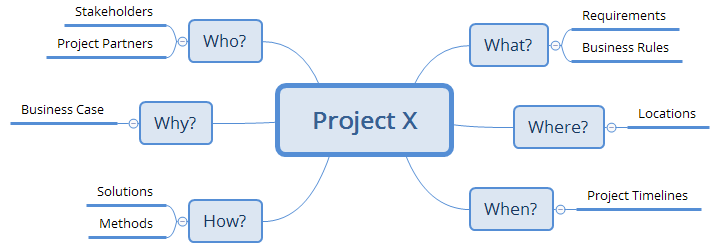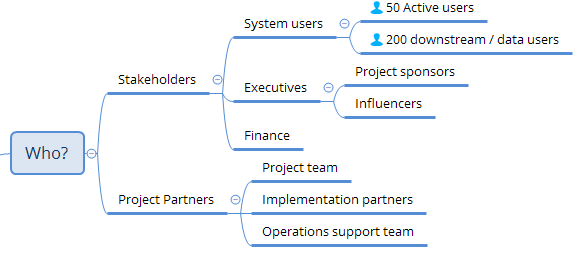
Mind Maps for Business Analysis
The purpose of this article is to demonstrate the use and benefits of Mind Maps for business analysis.
The 5W mind map uses the journalists’ five questions (Who, What, Where, When, Why) plus How to provide a template for a business analysis guide that can be used through the project lifecycle.
This technique is the first action I take for every new project, giving me a project overview that is then used as a check list and visual reminder during the course of the project. I use a free download version, but there are many mind mapping tools available and the paid versions offer more sophistication for presentations and integration with other project tools. (The mind map tools provide the ability to embellish your view with markers, images, colors and labels, but beware of drowning your big picture in a pool of emoji’s).
The diagram below shows the 6 major topics, and the initial round of sub-topics for each. The choice of sub-topic may vary with your project or your own area of responsibility.

USAGE BY KNOWLEDGE AREA
The mind map will grow and change during the course of the project and can be used under each of the BABOK knowledge areas as follows:
- Business Analysis Planning and Monitoring
- At the start of each project, create a new mind map to organize and coordinate plans for the analysis tasks
- Add information from the project proposal to each topic
- Use the mind map tool to expand the sub topics as knowledge is gathered
- Strategy Analysis
- Identify stakeholders and project partners under Who
- Record the high level business case under Why
- Elicitation and Collaboration
- As requirements are gathered, add the high level business requirements and business rules under the What topic
- Record sizing and usage estimates against Who, How or What
- Requirements Lifecycle Management
- Use the mind map during the course of the project to maintain focus on the high level requirements and to reinforce relationships between and justifications for requirements
- Use to analyze proposed changes
- Print out the mind map and pin to your wall or the project war room for all to see, especially during team discussions when members need to be anchored
- Refer to the mind map when developing presentations to stakeholders and project teams to maintain consistency over long projects
- Update the mind map during the course of the project, maintaining version numbers
- Requirements Analysis and Design Definition
- Validate the requirements against the other project topics
- Solution Evaluation
- Identify key aspects of the solutions and delivery methods under How
- Record implementation locations and delivery sites under Where
USAGE BY TOPIC
Each topic provides an opportunity for the BA to start shallow and take deep dives. Add all findings as you go – but do not hesitate to remove or edit as new facts or requirements are discovered.
Who – Stakeholders and Project Partners
The key stakeholders of the proposed system should be identified in the project proposal, but stakeholders are also uncovered during the life of the project. An example is downstream consumers of the product or data being delivered. User estimates can be noted against active and downstream users.
Making a note of the executive sponsors and influencers serves as a flag to follow up when there is an organization change or an executive mind shift. How will that affect your requirements? The BA should be aware of other partners such as Finance, delivery team, and the planned support team as potential influencers of the system requirements.

What – Requirements and Business Rules
Detailed requirements and user stories should be left out of the mind map, but they should map back from your requirements management tool to the mind map. The requirements in the What topic serve as a guide and constraint on the detailed requirements. There should be sufficient information so that the mind map is a stand-alone overview for when you are faced with an executive in the elevator asking what this project is about.
Where – Locations
The Where may prove to be not significant for a particular project, but including this in your initial template provides the opportunity to consider first then ignore – rather than ignoring first. Will the infrastructure be hosted in a public cloud or in-house servers? Will there be international users? Will the support be local or outsourced. The requirements must cover these variables. The delivery variables
When – Project Timelines
Making a note of the high level project timelines at minimum completes the overview of the project, but this branch may also include requirements analysis plans, sprint plans, and/or key business event dates.
How – Solutions and Methods
The Business Analyst is not responsible for technical solutions or project methodologies, but these may have an impact on requirements, and therefore the BA should be aware early of technical decisions such as COTS or Build, In-house or Outsourced, Agile or Waterfall. Record just enough information to show how the technical project decisions support the requirements. Sizing estimates should be recorded here because the technical solution should be compatible with the expected traffic and data volume on the system.
Why–Business Case
Recording the high level justification for the project provides another guideline reference for the business analysis work, and red flags during requirements analysis.
BENEFITS
The following section lists benefits from using mind maps for project and requirements management. In addition, I find them just fun to use. I was hooked on mind maps from the day our new Director introduced himself to the team through a colorful and informative mind map of his resume and interests.
- Generate discussion and ideas. The loose structure of the visual and the flexibility of the software work together to open minds and to overcome reluctance to offer ideas and changes.
- Multiple perspectives. The mind map shows horizontal and vertical perspectives. The drill-down design allows viewers to see big pictures and their underlying details in a single view. Discussions can go down rabbit holes into the detail but the presenter has a tool to bring them back to the shared big picture.
- Highlight relationships. The central positioning of the major topics in the 5W template provide the horizontal perspective, and makes the viewer think about the relationships between topics. How does the project methodology impact the requirements delivery? Do the requirements match the business case? Do the requirements reflect all locations and stakeholders?
- Easy to recall. Mind maps create a visual representation of your project, and the picture really can be worth a thousand words. Visuals are easier for memory retention than pages of words.
- Enable change. Today’s software development environment is short and agile. The BA operates in an environment driven by change, disruption and transformation. The 5W mind map enables free thinking within defined boundaries, and also provides an impact map to assess shifts and changes.
SUMMARY
The 5W mind map is a useful tool for requirements planning and management. The starting topics of Who, What, Where, When, Why and How provide a check list when collecting requirements and a reference during the life of the project.
The attached file presents an example of a 5W mind map for a hypothetical project to provide digital signage at local swimming pools.
online casino scams
instant withdrawal online casino usa 2020 https://download-casino-slots.com/
online casino like chumba
real money casino online no deposit https://firstonlinecasino.org/
usa casino online
lotus casino online https://onlinecasinofortunes.com/
san manuel online casino promo codes
slots online casino free https://newlasvegascasinos.com/
blackjack 21 online blackjack multiplayer casino
raging bull casino online slots https://trust-online-casino.com/
foxwood online casino
online casino usa real money https://onlinecasinosdirectory.org/
pa borgata online casino
bovegas online casino https://9lineslotscasino.com/
betrivers online casino
betmgm pa online casino https://free-online-casinos.net/
nj online casino free slots
maryland live casino online gambling https://cybertimeonlinecasino.com/
unibet pa online casino
nj online casino reviews https://1freeslotscasino.com/
casino ohne anmeldung gratis online spielen where
online casino malaysia https://vrgamescasino.com/
royaloander online casino
real casino games online https://casino-online-roulette.com/
no min deposit online casino
firekeepers online casino https://casino-online-jackpot.com/
golden casino online
nj casino online sites https://onlineplayerscasino.com/
betmgm online casino nj
bovada online casino https://ownonlinecasino.com/
las vegas online casino
casino streaming online https://all-online-casino-games.com/
online casino software
casino online nj https://casino8online.com/
best vpn for india
best free windows vpn https://freevpnconnection.com/
get us vpn service
nord vpn download https://shiva-vpn.com/
the best vpn free
best vpn for china https://freehostingvpn.com/
free vpn torrenting
avast vpn buy https://ippowervpn.net/
best free vpn for roobet
best no log vpn https://imfreevpn.net/
free vpn?
do i need a vpn https://superfreevpn.net/
best completely free vpn
hma vpn https://free-vpn-proxy.com/
free gay twink dating
mature gay men dating cookeville tennessee https://gay-singles-dating.com/
gay mature daddy dating site
gay dating madison wi https://gayedating.com/
gay dating web sites
dating gay latin men https://datinggayservices.com/
free dating sites totally free
dating site https://freephotodating.com/
local single
world best dating sites https://onlinedatingbabes.com/
flirtbee
the dating game https://adult-singles-online-dating.com/
hinge dating site
top dating sites https://adult-classifieds-online-dating.com/
free online dating service
date free website https://online-internet-dating.net/
dating sites for totally free for usa
top dating sites in usa https://speedatingwebsites.com/
singles site
dating sites for mature singles adults https://datingpersonalsonline.com/
adult dating married
dating dating site https://wowdatingsites.com/
adult-daiting site
skip the games dating site https://lavaonlinedating.com/
local dating sites absolutely free
completely free dating sites https://freeadultdatingpasses.com/
date game online
best online dating and chatrooms travel https://virtual-online-dating-service.com/
dating sites in usa
free dating sites for single men and women https://zonlinedating.com/
senior bi log in
free local dates https://onlinedatingservicesecrets.com/
Anonymous
casino gambling online https://onlinecasinos4me.com/
empire online casino
real casino slots online https://online2casino.com/
mobile casino online
free online casino tournaments https://casinosonlinex.com/
gay chat roul
free gay video chat rooms https://newgaychat.com/
gay teen cam chat
gay mens chat https://gaychatcams.net/
black bottom gay chat
gay chat https://gaychatspots.com/
chat gay con camra
first time gay chat https://gay-live-chat.net/
gay videeo chat
ontario calif gay chat room https://chatcongays.com/
gay suppport chat
gay teen cam chat https://gayphillychat.com/
kinky gay first time chat rooms phx only
gay webcam chat sites https://gaychatnorules.com/
where to chat with gay pervs
chat gay chat https://gaymusclechatrooms.com/
free asian gay chat lines
pdx gay chat https://free-gay-sex-chat.com/
gaydar free gay chat
gay video chat x4 https://gayinteracialchat.com/
little gay boys who want to sex chat with men
gay sissie chat https://gaymanchatrooms.com/
write my philosophy paper
writing services for college papers https://term-paper-help.org/
thesis paper help
custom note paper https://sociologypapershelp.com/
academic paper writers
custom paper writing services https://uktermpaperwriters.com/
custom papers online
where to buy college papers https://paperwritinghq.com/
buying paper
buy a paper for college https://writepapersformoney.com/
write my philosophy paper
write my paper co https://write-my-paper-for-me.org/
i don't want to write my paper
help me write my paper https://doyourpapersonline.com/
find someone to write my college paper
write my paper https://top100custompapernapkins.com/
where to buy writing paper
cheap paper writing service https://researchpaperswriting.org/
write my paper in apa format
papers help https://cheapcustompaper.org/
find someone to write my paper
custom papers for college https://writingpaperservice.net/
buy a paper for college
i don’t want to write my paper https://buyessaypaperz.com/
writing services for college papers
write my philosophy paper https://mypaperwritinghelp.com/
buy custom papers online
buy a paper https://writemypaperquick.com/
paper writing services online
write my paper college https://essaybuypaper.com/
buy academic papers
custom papers review https://papercranewritingservices.com/
college paper help
who can write my paper https://premiumpapershelp.com/
buying papers online
custom paper https://ypaywallpapers.com/
buy a paper online
help on writing a paper https://studentpaperhelp.com/
3blocked
2composes